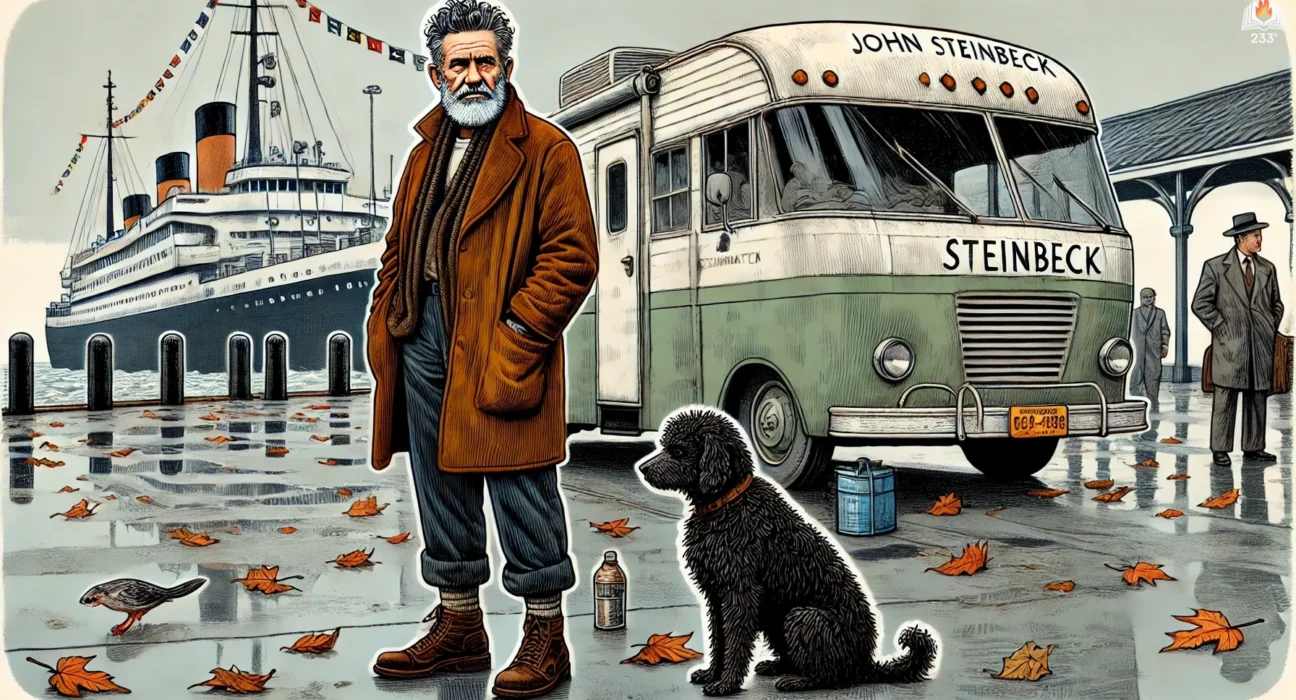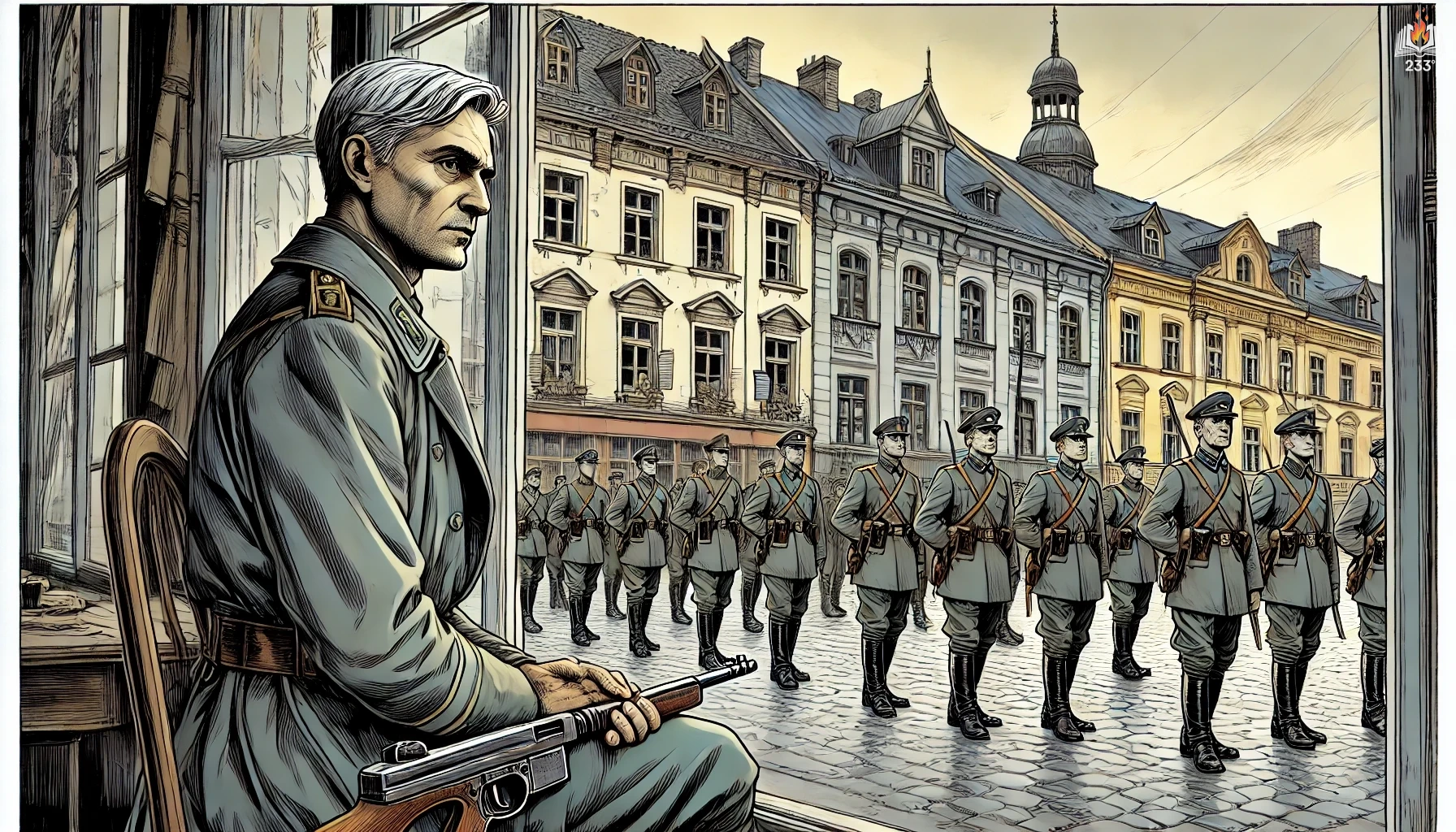Travels with Charley: In Search of America (1962) by Nobel laureate John Steinbeck is a reflective and evocative travelogue. At age 58, Steinbeck embarked on a road trip across America in a custom-built camper named Rocinante, with his French poodle Charley as his sole companion. Determined to reconnect with his country and its people, Steinbeck chronicles his observations on American society, landscapes, and the essence of human connection during a transformative era.
Plot Summary
A restless urge to reconnect with the American landscape drives an aging writer to embark on a solitary journey across the vast expanse of the United States. Equipped with a specially designed camper named Rocinante and accompanied only by his dignified French poodle, Charley, he sets forth to rediscover the country he believes has grown unfamiliar to him. The open road, imbued with both promise and uncertainty, becomes a canvas for reflection, observation, and rediscovery.
The journey begins in Long Island, New York, during the autumn of 1960, with a hurricane ominously signaling the start of the voyage. Escaping the storm’s aftermath, the writer ferries to New England. The dense forests and crisp air of the Northeast, tinged with the fiery hues of autumn, inspire a sense of wonder. In these landscapes, the man observes the stark contrasts between the timeless beauty of the natural world and the creeping homogeneity of modern life. Small towns hold a quiet charm, their whitewashed houses and roadside stands selling cider and pumpkins evoking a simpler past. Yet even here, hints of a changing America emerge in conversations with stoic New Englanders, who speak in clipped phrases but harbor deep yearnings beneath their reserved exteriors.
As Rocinante ventures westward, passing through industrial cities and rural hamlets, the writer finds himself immersed in the rhythms of the road. The solitude of driving allows his thoughts to wander, interspersed with Charley’s antics and the dog’s uncanny ability to break the ice with strangers. In Connecticut and Massachusetts, he encounters roadside diners where working men gather at dawn, their gruff demeanor softened by camaraderie and the shared rituals of coffee and breakfast. The writer listens more than he speaks, absorbing their stories and complaints, which reflect both pride and discontent in the American experience.
Further north, the landscapes shift to the rocky shores and icy winds of Maine. Here, the Atlantic crashes against ancient cliffs, and the wilderness feels untouched by time. The writer visits Deer Isle, a remote and idyllic corner where the pace of life seems to slow. Among the locals, he senses an enduring connection to the land, even as modern conveniences encroach. The simplicity of these interactions leaves a lasting impression, a counterpoint to the hurried pace of urban centers.
From New England, Rocinante winds its way southward and into the Midwest. The vast plains stretch endlessly, the golden fields shimmering under an expansive sky. Conversations with farmers and small-town residents reveal a mix of resilience and unease. The writer notes the rise of roadside culture—garish signs, fast food chains, and disposable consumer goods—that signals a shift in values. The beauty of the land contrasts sharply with these symbols of transience and excess, evoking a sense of nostalgia for a fading way of life.
As he ventures further into the heartland, the writer observes the unique character of each region, shaped by its people, geography, and history. In the Dakotas and Montana, the rugged terrain mirrors the hardy spirit of the locals. The discussions here often turn to the land itself—its bounty, its challenges, and its fragility. He marvels at the untouched splendor of the Badlands and Yellowstone, where nature asserts its dominance over human ambitions. These moments in the wilderness are a balm to the traveler’s soul, offering a reprieve from the increasing complexities of human society.
The journey turns southward through Wyoming and Colorado, where the landscapes become a tapestry of mountains and valleys. In this region, he witnesses the profound connection between humans and their environment. Ranchers, hunters, and outdoor enthusiasts share tales of the land’s unforgiving beauty, and their words resonate with the writer’s own reverence for the natural world. Charley, ever curious and endearing, continues to charm strangers, serving as an ambassador in these encounters.
In the Southwest, the deserts of Arizona and New Mexico stretch vast and otherworldly, their stark beauty accentuated by the fiery reds and oranges of the earth. The writer reflects on the resilience required to inhabit such a harsh landscape. Here, the conversations often turn philosophical, with locals pondering the balance between preserving traditions and embracing progress. The writer senses a growing tension between these forces, a theme that threads through his entire journey.
Reaching California, the traveler confronts a blend of nostalgia and dismay. The Golden State, once emblematic of opportunity and beauty, now feels burdened by overpopulation and urban sprawl. Yet pockets of its former charm remain—in coastal towns and agricultural valleys that echo the America of his youth. This contrast between the old and the new, the wild and the tamed, deepens his reflections on change and loss.
As the trip continues along the southern states, the writer encounters a different America. The South, with its lush landscapes and deep cultural roots, offers a stark contrast to the homogenized northern cities. Conversations here reveal tensions—racial, political, and economic—that simmer beneath the surface. In places like Louisiana and Texas, he witnesses both the enduring warmth of Southern hospitality and the lingering shadows of segregation and inequality. The writer listens, observes, and refrains from judgment, allowing the complexities of these encounters to shape his understanding of the nation’s challenges.
Turning northward, Rocinante finally winds through the Appalachian region, where the rugged beauty of the mountains provides a fitting conclusion to the journey. The writer, now physically weary but spiritually enriched, reflects on the lessons of the road. America, he realizes, is a land of contradictions—a country both divided and united, shaped by its diversity yet yearning for common ground. The landscapes, people, and stories he has encountered form a mosaic of a nation in flux, grappling with its identity in an era of rapid change.
As the journey ends, the writer returns home with a newfound appreciation for the complexity of the country he had set out to rediscover. The road has revealed not just the contours of the land but the soul of its people—their hopes, fears, and enduring spirit. And through it all, Charley’s quiet companionship has been a constant reminder of the simple joys that ground life’s most profound explorations.
Main Characters
- John Steinbeck: The narrator and author, Steinbeck brings a blend of curiosity, humor, and introspection. As a restless traveler, he seeks to understand America’s heart and soul while reflecting on his own life.
- Charley: Steinbeck’s loyal French poodle and travel companion. Charley is observant, dignified, and occasionally humorous, serving as a bridge between strangers and Steinbeck.
- Rocinante: Though not a character in the traditional sense, Rocinante (the camper named after Don Quixote’s horse) serves as both home and vessel, enabling Steinbeck’s exploration.
Theme
- Restlessness and the Call of the Open Road: Steinbeck captures the universal longing for movement and freedom, exploring how travel enriches one’s perspective and fosters growth.
- The American Identity: Through interactions and observations, Steinbeck examines the complexities and contradictions of American culture during a period of rapid change.
- Isolation and Connection: The journey delves into loneliness versus companionship, highlighting Charley as an emotional anchor and the ways travel fosters unexpected human connections.
- Nature and Environment: Vivid descriptions of landscapes reflect America’s beauty and ecological challenges, underscoring a deep reverence for nature.
- Change and Nostalgia: Steinbeck wrestles with the passage of time, observing societal shifts and grappling with the loss of a simpler past.
Writing Style and Tone
John Steinbeck’s writing in Travels with Charley is deeply personal and conversational, blending poetic descriptions with sharp insights. His prose alternates between reflective and humorous, capturing both the majesty of the American landscape and the quirks of its people.
Steinbeck employs rich imagery to evoke the sensory experiences of travel, often weaving metaphor and symbolism into his observations. His tone is contemplative yet tinged with a sense of melancholy, as he both celebrates and critiques the evolving American landscape and culture. This duality lends his narrative a timeless quality, resonating with readers as an honest exploration of identity and belonging.
We hope this summary has sparked your interest and would appreciate you following Celsius 233 on social media:
There’s a treasure trove of other fascinating book summaries waiting for you. Check out our collection of stories that inspire, thrill, and provoke thought, just like this one by checking out the Book Shelf or the Library
Remember, while our summaries capture the essence, they can never replace the full experience of reading the book. If this summary intrigued you, consider diving into the complete story – buy the book and immerse yourself in the author’s original work.
If you want to request a book summary, click here.
When Saurabh is not working/watching football/reading books/traveling, you can reach him via Twitter/X, LinkedIn, or Threads
Restart reading!








